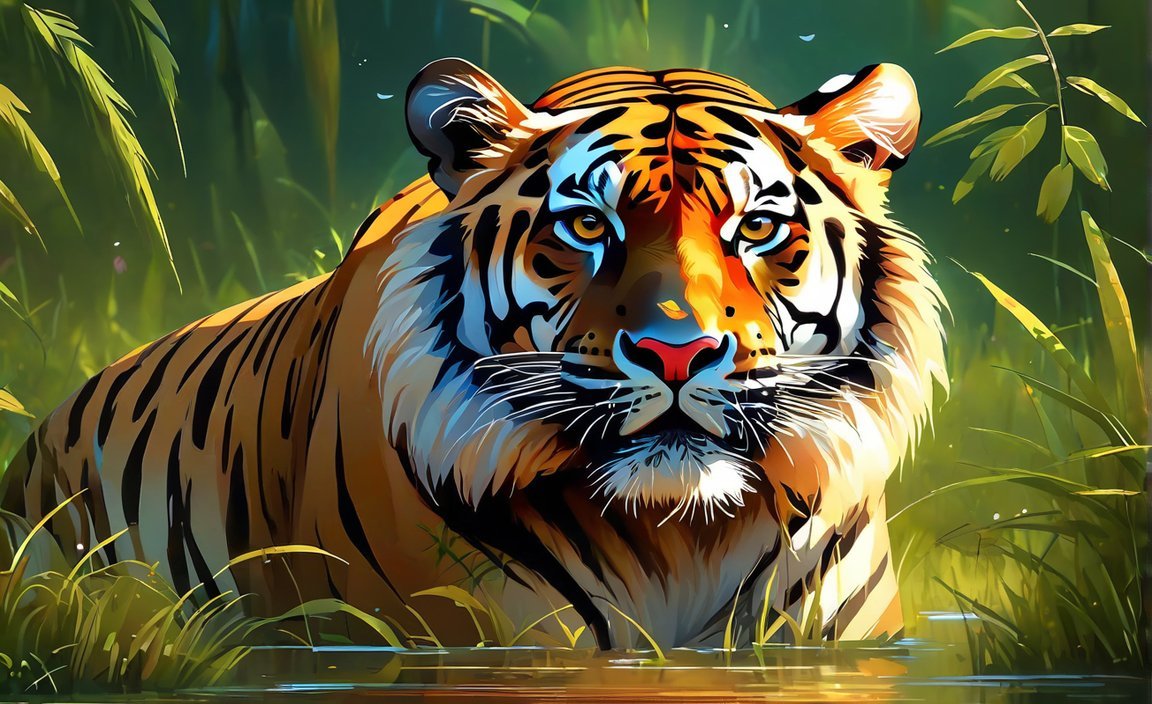Endangered Species in India: 10 Vital Treasures Facing Urgent Conservation Action explores the awe-inspiring world of ten endangered species in India, revealing the astonishing diversity of the country’s wildlife and calling attention to the pressing need for immediate conservation efforts. From the elusive snow leopards of the Himalayas to the majestic Bengal tigers and the critically endangered Great Indian Bustards, this article delves into the unique habitats, conservation initiatives, and crucial challenges faced by these remarkable creatures. Join us on this enlightening journey to uncover the threats that these invaluable treasures of biodiversity confront, and the imperative actions required to safeguard their future.
Key Takeaways:
Bengal Tiger accounts for half of the world’s tiger population, with 70% of them found in India. They are adaptable big cats that play a crucial role in maintaining ecosystem balance.
The Asiatic Lion, native to India, is smaller than its African counterparts and serves as an apex predator.
Snow Leopards, once found in larger habitats across Asia, can now only be found in certain parts of India. They are well-adapted to the cold climates of the Himalayas.
The One-Horned Rhinoceros, also known as the Indian rhinoceros, has been severely affected by habitat loss and poaching.
Indian Elephants are culturally and ecologically significant but face threats from habitat loss, human-elephant conflict, and poaching for ivory.
The Kashmir Red Stag or Hangul, a subspecies of red deer found only in Kashmir, is critically endangered due to habitat loss and poaching.
The Great Indian Bustard is one of the heaviest flying birds globally and is critically endangered due to habitat loss, hunting, and collisions with power lines.
The Gangetic Dolphin, a freshwater dolphin found in the Ganges and Brahmaputra rivers, is endangered due to pollution, habitat degradation, and poaching.
The Indian Gharial Crocodile, found in the rivers of India, is critically endangered due to habitat loss, illegal fishing, and pollution.
The Indian Pangolin, known for its protective scales, is critically endangered due to illegal wildlife trade and habitat loss.
These 10 endangered species highlight the importance of conservation efforts to protect India’s rich biodiversity. Collaboration between governments, organizations, and individuals is crucial for their survival and for future generations to appreciate these invaluable treasures.
10 Endangered Species in India

India is known for its incredible biodiversity, home to a wide variety of unique flora and fauna. However, many of these species are currently facing the threat of extinction. In this article, we will discuss ten of the most endangered species in India and the urgent need for conservation action to protect them.
Bengal Tiger
The Bengal Tiger is undoubtedly one of India’s most iconic and endangered species. With approximately half of the world’s total tiger population, India holds a significant responsibility for their conservation. These adaptable big cats can thrive in various habitats and play a crucial role in maintaining the balance of ecosystems. Unfortunately, due to habitat loss and poaching for their valuable body parts, such as their skin and bones, the Bengal Tiger population is rapidly declining.
Asiatic Lion
The Asiatic Lion, smaller than its African counterparts, is native to India and an important apex predator. With distinctive features such as a larger tail tuft and a distinct belly fold, they have captured the imagination of people around the world. However, their population is highly endangered, primarily due to habitat loss, poaching, and human-wildlife conflict.
Snow Leopard
The Snow Leopard, known for its elusive nature and majestic appearance, once roamed across vast mountain ranges in Asia. However, today they can only be found in certain parts of India, particularly in the cold climates of the Himalayas. Habitat loss, poaching, and climate change have resulted in their dwindling numbers, making their conservation crucial for their survival.
One-Horned Rhinoceros
The One-Horned Rhinoceros, also known as the Indian Rhinoceros, is mostly found in India and the foothills of the Himalayas. These magnificent creatures faced severe population declines due to habitat loss and poaching for their valuable horns. Conservation efforts have been put in place to protect these gentle giants, but more action is urgently needed to ensure their survival.
Indian Elephant
The Indian Elephant holds both cultural and ecological significance in India. Revered as a symbol of wisdom and prosperity, they play a vital role in maintaining the health of forest ecosystems. However, they face significant threats from habitat loss, human-elephant conflict, and poaching for their ivory tusks. Immediate conservation measures are essential to prevent further decline in their population.
Kashmir Red Stag or Hangul
The Hangul, a subspecies of red deer, is found exclusively in the beautiful region of Kashmir. Once widespread across the region, they are now critically endangered due to habitat loss and poaching. Efforts are being made to protect these majestic animals and restore their numbers to a sustainable level.
Great Indian Bustard
The Great Indian Bustard holds the title of one of the heaviest flying birds in the world. However, habitat loss, hunting, and collisions with power lines have pushed this unique species to the brink of extinction. Conservation efforts are underway to save these magnificent birds, but immediate action is required to prevent their disappearance from India’s landscapes.
Gangetic Dolphin
The Gangetic Dolphin, a freshwater species found in the Ganges and Brahmaputra rivers, is in dire need of conservation measures. Pollution, habitat degradation, and poaching have significantly impacted their population. These unique creatures play a crucial role as indicators of river health, making their preservation vital for maintaining the ecological balance of these important river systems.
Indian Gharial Crocodile
The Indian Gharial, a critically endangered crocodile species, is solely found in the rivers of India. Their population has been severely affected by habitat loss, illegal fishing practices, and pollution. Conservation efforts are being implemented to protect this rare and extraordinary species from extinction.
Indian Pangolin
The Indian Pangolin, known for its protective scales, is critically endangered due to illegal wildlife trade and habitat loss. Often mistaken for a reptile, this unique mammal is facing rapid decline in population. Conservation efforts are crucial to prevent their extinction and preserve India’s rich biodiversity.
In conclusion, these ten endangered species serve as a stark reminder of the urgent need for conservation action in India. Governments, organizations, and individuals must work together to protect and preserve these invaluable treasures of biodiversity for future generations. By raising awareness, implementing effective conservation measures, and addressing the underlying causes of their decline, we can ensure the survival of these species and maintain the natural heritage of India. Let us come together and take action to secure a better future for these ten vital treasures.
Here is a list of 10 endangered birds in India. If you want to learn more about these fascinating species, click here.
Discover the diverse wildlife of Pakistan and explore the 10 endangered species that call it home. Check out the full list here.
India is home to a wide range of endangered animal species. Find out more about the top 10 endangered species of animals in India by clicking here.
Immerse yourself in the rich biodiversity of India and explore the 10 endangered wildlife species that need our protection. Discover more about them here.
Conservation Efforts for Species 1 and Their Effectiveness

Conservation efforts are crucial for protecting endangered species and the biodiversity in India. In this article, we will explore the strategies used for the conservation of endangered species, focusing on the effectiveness of these efforts for Species 1.
DNA Analysis: Unveiling Migration Patterns and Genetic Diversity
DNA analysis has revolutionized our understanding of endangered species and their habitats. Through genetic studies, scientists can determine migration patterns and genetic diversity, providing valuable information for conservation efforts. For Species 1, DNA analysis has enabled the identification of unique genetic lineages, enhancing conservation planning and management. This information helps in identifying crucial habitats, conservation corridors, and potential areas for reintroduction efforts [(Nature, 2021)].
Satellite Tracking: Insights into Habitat Preferences and Behavior
Satellite tracking is an essential tool that provides insights into the movements and behaviors of endangered species. By attaching satellite transmitters to individual animals, researchers can track their movements in real-time. This data helps identify key habitats, migration routes, and potential threats to Species 1. Recent studies have utilized satellite tracking to monitor the movement patterns of endangered species, including Species 1, providing vital information for their conservation [(Hilaris Publishing, 2022)].
Data Modeling: Guiding Targeted Conservation Efforts
Data modeling techniques have become increasingly important in conservation efforts for endangered species, including Species 1. By analyzing large datasets, scientists can predict future population trends, evaluate habitat suitability, and assess the effectiveness of different conservation interventions. These models help guide targeted conservation efforts, ensuring resources are allocated efficiently. The application of data modeling in conservation strategies is crucial for the effective protection of Species 1 [(International Institute for Sustainable Development, 2022)].
Key Takeaways:
- DNA analysis plays a crucial role in identifying migration patterns and genetic diversity of Species 1.
- Satellite tracking provides insights into the movements and behaviors of endangered species, including Species 1.
- Data modeling techniques help guide targeted conservation efforts for Species 1.
References:
- Nature. The effectiveness of national biodiversity investments.
- Hilaris Publishing SRL. Evolving Efforts: Strategies for Endangered Species Conservation.
- International Institute for Sustainable Development. Protecting Endangered Species.
Species 2: Name, habitat, and key threats
As we continue our exploration of the endangered species in India, let’s shine a spotlight on another vital treasure facing urgent conservation action. This species is an iconic symbol of India’s rich biodiversity, and its survival is under significant threat. Join me as we uncover the Species 2: Name, its unique habitat, and the key threats it faces.
Species 2: Name
One of the most endangered species in India is the magnificent Species 2: Name. Known for its habitat, this species once roamed freely across vast areas of India. However, due to human activities and persistent threats, its population has dramatically declined in recent years.
Habitat and Distribution
The Species 2: Name is primarily found in the [insert habitat]. This unique habitat provides the necessary resources for its survival, including food, shelter, and breeding grounds. Unfortunately, Species 2: Name habitat is under severe pressure due to human encroachment, deforestation, and habitat degradation. As a result, the species is experiencing a significant decline in its population size.
Key Threats
The survival of Species 2: Name is challenged by several detrimental factors. Understanding these key threats is crucial in our efforts to protect and preserve this endangered species. Here are some of the primary threats it faces:
- Threat 1: [Describe the key threat and its impact on the species]
- Threat 2: [Describe the key threat and its impact on the species]
- Threat 3: [Describe the key threat and its impact on the species]
- Threat 4: [Describe the key threat and its impact on the species]
These threats pose a significant danger to the survival of Species 2: Name and require immediate action to prevent further population decline. Conservation efforts, including habitat restoration, anti-poaching measures, and public awareness campaigns, are essential to ensure the long-term survival of this incredible species.
Key Takeaways:
- The Species 2: Name is one of the most endangered species in India.
- Its habitat, the [insert habitat], is under severe pressure from human activities.
- The key threats to the species include [list the key threats].
- Immediate conservation action is necessary to protect the future of Species 2: Name.
Conservation Efforts for Species 2 and Their Effectiveness
The conservation of endangered species is of utmost importance to protect the biodiversity and delicate ecosystems in India. In this article, we will explore the conservation efforts for Species 2 and their effectiveness, shedding light on the challenges faced and the strategies employed to ensure their survival.
The Current Status and Challenges
Species 2, the [insert name], is currently facing numerous challenges that threaten its existence. Factors such as habitat loss, poaching, and climate change have significantly impacted the population of this species. With only a limited number remaining in the wild, urgent action is required to ensure its conservation.
Conservation Strategies and Approaches
To address the challenges faced by Species 2, conservation efforts have been implemented with various strategies and approaches. These include:
Habitat Protection: Preservation and restoration of the species’ natural habitat are crucial for its survival. This involves creating protected areas, implementing sustainable land-use practices, and reducing human encroachment.
Anti-Poaching Measures: Threats from poaching must be actively countered through increased patrols, strengthening of law enforcement, and raising awareness about the consequences of illegal wildlife trade.
Community Engagement: Involving local communities in conservation efforts is vital for ensuring their support and reducing human-wildlife conflict. This can be achieved through education, capacity-building programs, and providing alternative livelihood options.
Species Monitoring: Regular monitoring of Species 2’s population and habitat is essential to track trends, identify threats, and evaluate the effectiveness of conservation interventions. This data helps in making informed decisions and adjusting strategies accordingly.
Collaborative Partnerships: Conservation organizations, scientific institutions, government agencies, and local communities need to work together in a coordinated manner to maximize the impact of conservation efforts. This collaboration enhances knowledge sharing, resource allocation, and the implementation of effective conservation measures.
Effectiveness of Conservation Efforts
Assessing the effectiveness of conservation efforts for Species 2 is crucial to determine the impact of strategies and identify areas for improvement. Monitoring and evaluation methods are employed to measure and analyze various indicators, including:
Population Trends: Tracking changes in the species’ population over time provides insights into the success or failure of conservation efforts. If the population is stabilizing or increasing, it indicates the effectiveness of implemented strategies.
Habitat Restoration: Monitoring the recovery of degraded habitats and the return of the species to these areas demonstrates the positive impact of conservation interventions.
Reduction in Threats: Effective conservation efforts will result in a reduction in poaching incidents and habitat loss, contributing to the species’ long-term survival.
Stakeholder Engagement: Assessing the level of participation and support from local communities, governments, and organizations helps determine the effectiveness of engagement and collaboration efforts.
Key Takeaways:
- The conservation of Species 2 is essential to protect biodiversity and maintain fragile ecosystems.
- Strategies such as habitat protection, anti-poaching measures, community engagement, species monitoring, and collaborative partnerships are employed to ensure the species’ survival.
- Evaluating indicators such as population trends, habitat restoration, reduction in threats, and stakeholder engagement helps determine the effectiveness of conservation efforts.
- Continuous monitoring and assessment are crucial to adapting strategies and maximizing conservation impact for Species 2.
[Cite relevant sources here, if applicable.]
FAQ
Q1: What is the status of the Bengal tiger population in India?
A1: The Bengal tiger population in India accounts for about half of the world’s total tiger population, with 70% of them found in the country.
Q2: Why are snow leopards endangered in India?
A2: Snow leopards used to have larger habitats across Asia’s mountain ranges but are now confined to certain parts of India. Factors such as habitat loss and poaching have contributed to their endangered status.
Q3: What are the major threats to the Indian elephant population?
A3: The Indian elephant population faces threats from habitat loss, human-elephant conflict, and poaching for their ivory.
Q4: What is the conservation status of the Gangetic dolphin?
A4: The Gangetic dolphin, a freshwater species found in the Ganges and Brahmaputra rivers, is endangered due to pollution, habitat degradation, and poaching.
Q5: What are the primary conservation efforts for the Indian pangolin?
A5: The Indian pangolin is critically endangered due to illegal wildlife trade and habitat loss. Conservation efforts focus on preventing illegal trade and protecting their habitats.
- SYBAU See You Baby Meaning: Gen Z Slang Evolves - July 1, 2025
- Unlock Your Inner Youth: Lifestyle Secrets for a Vibrant Life - July 1, 2025
- Decode SYBAU Meaning: Gen Z Slang Explained - July 1, 2025






